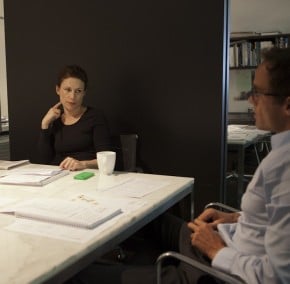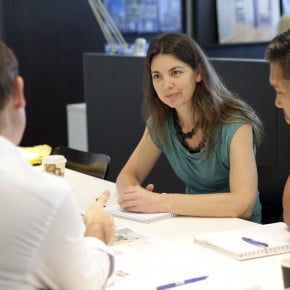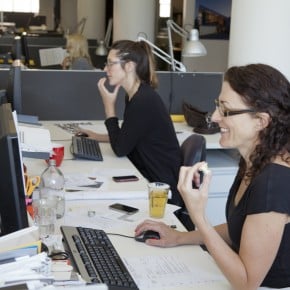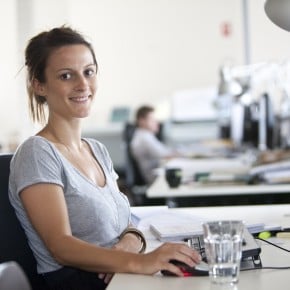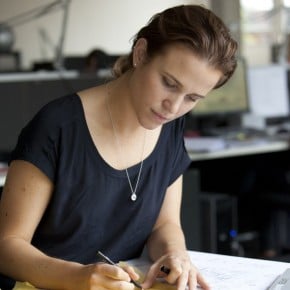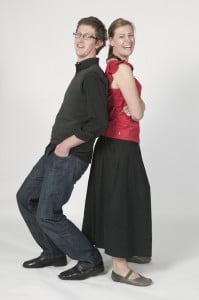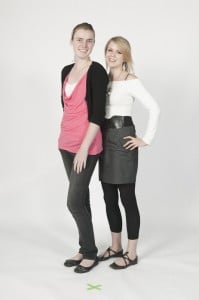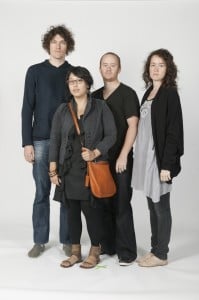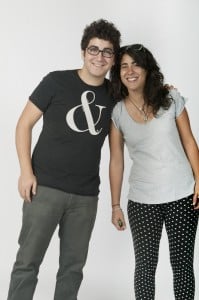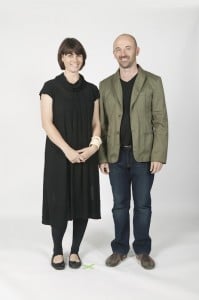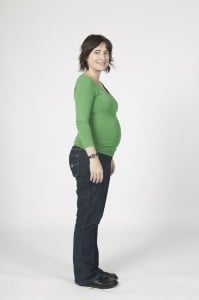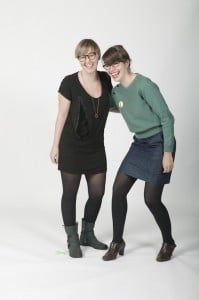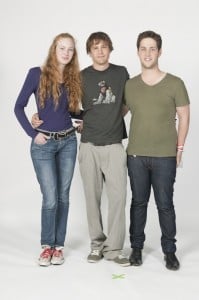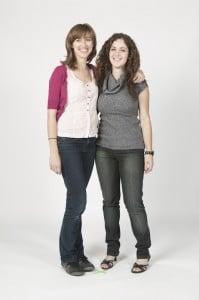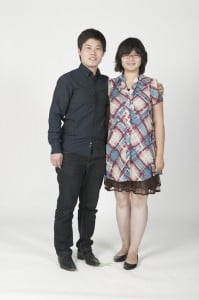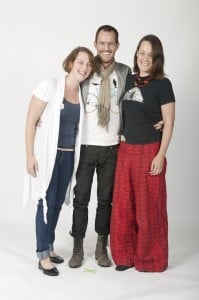Showing practice. Naomi Stead describes the intent and context of the ‘visual sociology’ component of the Women, Work and Leadership research project.
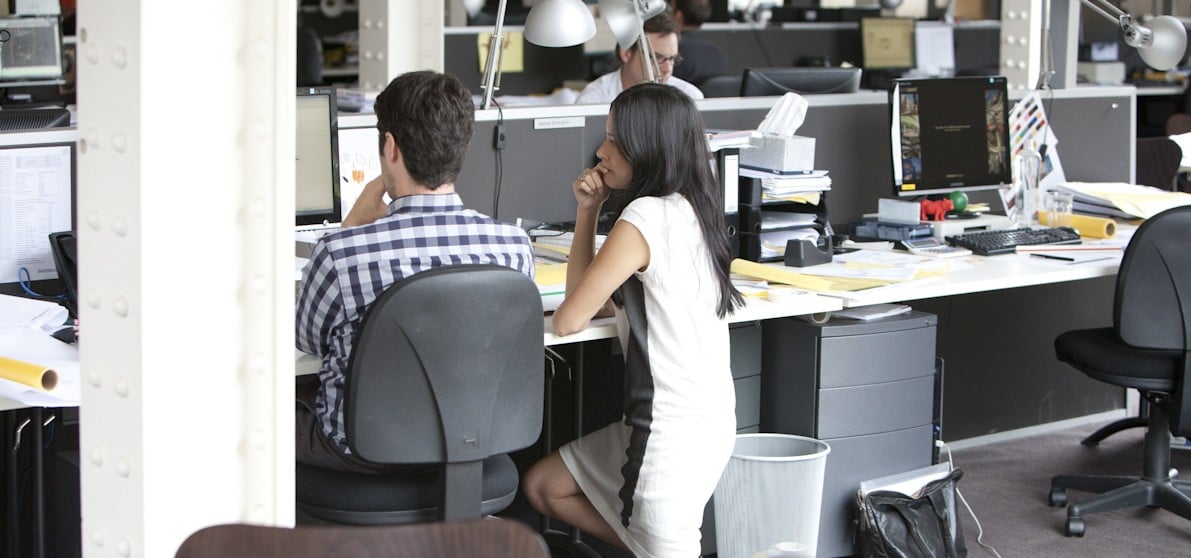
This photograph and all following by Nick Bassett.
One of the innovative elements of the Women, Work and Leadership research project is its use of visual methodologies to document, analyse and understand the culture of specific architectural offices, the professional identity of architects (particularly women architects), and the material culture of architectural office environments more broadly. This component of the research is variously described as a visual sociology, a visual archaeology, and a visual archive, although it might more correctly be described as a visual documentation. Images from this documentation are also used across this website.
So, what does visual documentation entail? How does it differ from other, existing (textual) studies of architectural office culture?
The project involves collecting a documentary archive of photographic images. Nick Bassett, a professional photographer working under instruction from the research team and in collaboration with the three case study practices themselves, will spend time in each office, documenting the place and its people in detail. This supplements the textual and discursive accounts gathered in parallel by Gill Matthewson, in fieldwork as part of her PhD.
The first purpose of the visual documentation is to gather ethnographic research material – a repository and archive of images and portraits, a rich body of data on the socio-cultural environment of three architecture offices in the early twenty-first century. This capturing of the minutiae of the office environment is expected to reveal not only the physical characteristics of the places where architects spend their days, but also something of their expression of professional and practice identity.
This leads me to the second purpose of the visual archive – to produce and publicly disseminate a more accurate image of architects at work.
Given that the public perception of architecture tends to be of a male-dominated profession, it is important to demonstrate the profusion of women who already work successfully in the field. Thus in addition to the documentation of the work environment, the project will undertake a series of studies and portraits of female architects in professional context. Directed at the broader community, this showcasing of positive examples of women architects, in their work environments, is an attempt to raise the profile of women in the profession and the visibility of their contributions.
It works to debunk the idea that architecture is the playboy pursuit sometimes depicted in popular culture in which, for instance, male architects are vastly over-represented as characters in narrative film. It is important that potential future architects have a more accurate sense of what architectural work actually entails, with a more realistic portrait of everyday life in an architectural office, including the fact that this is a place and a profession for women as well as men. The visual documentation is also a demonstration to current and future students, as well as to other women in the industry, of positive role models – exemplary women demonstrating the prevalence and value of female architects’ contributions.
It is appropriate to use visual methodologies in a project about architects, since architects are highly-trained visual communicators, adept in the production, analysis, manipulation, and ‘reading’ of images. Architecture is an intensely visual practice, and many of its outcomes and ideas are most effective communicated visually. One of the potential benefits of the visual archive is thus the ability to communicate effectively with the broader architectural community, including dissemination to a larger public audience: quite literally increasing the visibility of women architects and their achievements. The use of photographs from the visual documentation on this website is a direct example of this mode of communication.
Ethnographic studies of architecture offices – where is the visual?
I have borrowed and adapted the title of this short essay from a chapter of Dana Cuff’s brilliant ethnographic study of architectural office culture, Architecture: The Story of Practice. Her close, minute examination of the interpersonal interactions and processes that take place in architecture offices stands out from the large proportion of research on architects that has been survey or questionnaire-based. Cuff’s study attends not just to what people say happens in architecture offices, but what can be observed happening – often without the participants themselves fully realising. Cuff’s chapter 5, ‘The Architect’s Milieu’, attends to the ‘coherent system of meaning’ that is an architecture office, a ‘social milieu of practice’ where she finds ‘regular patterns of interaction recurring within very different firms.’ 1
Cuff argues that one of the reasons why architects choose to work together in collective practice is that this gathering together of professionals (who could equally choose to work alone or separately) constitutes a ‘meaningful world for themselves and their actions.’ Architecture, like other professional communities, ‘is a cultural microcosm, giving practitioners their bearing in the world.’ She goes on to describe the particularities of architectural office heritage, dialect, values, practices, rituals, and roles, and how these interact to create a particular office culture. The milieu of the office is thus a space in which the architect can ‘forge and express a coherent professional identity.’ She goes on:
This milieu is not a static, predetermined social scene; rather the architects in a firm together create the setting for their actions. The setting is dynamic, shifting slightly as the firm grows, adds and loses members, gains new clients, and the broader context evolves with subtle changes in the economy, the building industry, or the available technology. … The milieu of each firm is unique and in flux, but underlying their uniqueness, firms share certain structural characteristics. The first is an office’s heritage, which involves the origins and founders of a firm, often recollected in legends analogous to creation myths. Other characteristics include office members’ use of language, their power structure, and their prevailing practices and values.2
In her study, Cuff is largely concerned with the interpersonal and social interactions that build such an office culture, and many of her ideas will also be examined by Gill Matthewson in her close study of the three case study firms that the Women, Work and Leadership project addresses. But the visual component of the research is important in that it attends to these same questions by attending to the physical and material environment of the architectural office, and the ways in which professional identity, values, office heritage, and rituals might be manifest visually. There have been very few such visual studies of architectural culture, in particular that of medium to large practices, so this project will make a contribution to a growing and important body of research work. One project that has already been completed, by members of the research team, is a direct predecessor of the work being undertaken here.
Documentation: The Visual Sociology of Architects
In 2010 Sandra Kaji-O’Grady, Kate Sweetapple and I worked with photographer Nick Bassett on a small visual research project that became the precursor to this one. That project, Documentation: The Visual Sociology of Architects, occurred at the conference of the Australian Institute of Architects. It was provoked by Melanie Dodd, the Creative Director of the 2010 conference, who opened a call for a series of ‘actions’ to take place at the margins and in the interstitial spaces of the conference venue.
Drawing upon objectivist serial art practices established in the 1960s, the Documentation project proposed a visual archaeology of architects, just as it documented the participants at a specific architectural event at a particular historic moment. Each participant was photographed in a full-length portrait against a uniform backdrop, from a uniform frontal position, posed in a manner of their own choosing. Gathering images from the large national sample of architects attending the conference was an attempt to reveal an image of collective professional identity, complete with particular visual traits, patterns, similarities and differences: a sociology of the profession in images. In this sense, the project was a counterpoint to the exhibition ‘Portraits and Architecture,’ mounted at Canberra’s National Portrait Gallery in late 2009, which highlighted seven Australian architecture practices through commissioned photographic portraits, explicitly linking creative practice to visual identity. By contrast, the Documentation project follows the objectivist strategies of the Dusseldorf school of photographers, gathering visual data towards a portrait of the profession as a collective, rather than an emphasis on portraits of individual architectural ‘authors’. As the image archive grew over the course of the conference, the photographs were printed and displayed in-situ in clusters arranged by visual similarity. A visually fascinating and engaging display, the eventual collection comprises an important historic record, as well as reflecting the ‘extra/ordinariness’ of the profession back to itself.
The internal professional culture of architecture – the image of what and whom is an architect – is both strong and well subscribed, with a common vocabulary of visual tropes, props, and shared social and aesthetic values. This culture has local variations, but is also remarkably consistent across international lines. The stories that make up such a culture are transmitted and constructed through architectural media, institutionalised through awards, and inculcated through architectural education, but importantly they are also manifest in a series of recognisable visual cues. The Documentation project made this quite clear. A short description and discussion of the project has been published in Architecture Australia, and the images can be viewed online through Flickr, but the research team plans further publications about this archive in the future.3 With its focus on the visual manifestations of professional identity, and the ways in which gender inflects this, the project is a direct precursor to the Women, Work and Leadership project’s visual research aims. But it is all very well to describe the aims and ideals of visual research – it is another thing to actually achieve such things, in what is a new and still contested field and body of research methods. Therefore it is worthwhile to sketch some arguments from the recent theoretical literature in this area.
Understanding and using visual research methodologies
In Gillian Rose’s book Visual Methodologies, she describes the potential and also some pitfalls of research using visual materials. Photographs, drawings, maps and other types of image are frequently used by researchers as visual evidence, and also as an instrument for eliciting information, for instance by asking interview subjects to discuss a family photograph. Much of Rose’s book is taken up with the interpretation of ‘found’ images, those that pre-date the researcher’s presence, but she also discusses the relatively new practice of researchers making images as an integral part of their methodology. This has a long tradition in anthropology and ethnography, where drawings, photographs and films have historically been used to collect representations, but in recent years the practice has extended to other types of image, and other research fields.
The medium of photography has complexities all of its own, and the days have long gone when photographic images were seen as transparent and unmediated presentations of the real. Photographs are framed and selected and edited, and things cropped in or out, just as subjectively as in a painting. But even if the idea is abandoned, of the camera as a purely objective machine for revealing reality, there are still things that photographs can do that other kinds of image, or text, can not. In Rose’s terms, photographs are used by social scientists ‘because they can carry or evoke three things – information, affect and reflection – particularly well.’ 4
Rose describes purpose-made photographic research images as falling into two camps – those in support of research, and those which are supplementary to it. The distinction here is that the first uses photographs ‘as evidence to be interpreted by the researcher (often in conjunction with interviewees),’ while the latter ‘give more space to the photographs themselves to have their own, perhaps rather unpredictable, effects in the research process.’5 The idea in both of these cases is that photographs can bring something to research that speech and writing and other textual approaches can not;
These are not images that simply illustrate some aspect of the research project: what Marcus Banks calls a ‘largely redundant visual representation of something already described in the text.’ Instead, in these methods, the images are used actively in the research process, alongside other sorts of evidence generated usually by interviews or ethnographic fieldwork.6
In this project, where the photographic archive is being collected alongside more conventional ethnographic fieldwork being undertaken by Gill Matthewson, the images have a particular kind of agency of their own. They fall into the category of photographs supplementary to the research – they are not simply illustrative, nor simply evidentiary, but have a life of their own as photographs, with all the attendant ambiguities of that, in both form and content. Rose discusses two aspects of a research subject that photographs alone can capture – namely ‘specified generalization’ (a concept she derives from Howard Becker) and ‘texture’ (derived from the work of Alan Latham). As Becker writes:
What can you do with pictures that you couldn’t do just as well with words (or numbers)? The answer is that I can lead you to believe that the abstract tale I’ve just told you has a real, flesh and blood life, and therefore is to be believed, in a way that is hard to do when all you have is the argument and some scraps and can only wonder if there really is anyone like that out there.7
The effect of such photographs is to ‘affirm the veracity’ of the argument being put forward through the text.8 In this way, images of women architects and their workplaces are not ‘evidence’ towards any particular argument about gender and architecture, or industrial relations in architecture, or gender equity – they are rather exemplars and instantiations of the women who work every day in architecture offices, throughout Australia, and who face questions of gender and identity by virtue of their very presence in the workplace – unavoidably and inevitably. As Rose writes of such photographs, ‘it is their effect that matters, not their source.’8
‘Texture’ is an even more interesting category of effect for architects, since it deals with the mood or feel of a place, those most elusive qualities. The intense and dense visual information in a photograph, as well as its formal attributes asa photograph, can convey this quality. The visual research in this project will set out to capture both the ‘specified generalization’ of life as a woman architect, and the ‘texture’ of an architecture office. This aspect of the project is expected to have an on-going life beyond the scope of the current study, with the possibility of an exhibition and further publications.
- Dana Cuff, Architecture: The Story of Practice (MIT Press, Cambridge, Mass., 1992) p. 156.[↩]
- Cuff, Architecture: The Story of Practice p. 157.[↩]
- Naomi Stead, ‘Documentation: The Visual Sociology of Architects,’ Architecture Australia 99, no. 4, July/August 2010, pp. 64-65[↩]
- Gillian Rose, Visual Methodologies: An Introduction to the Interpretation of Visual Materials, second edition (Sage, London, 2007) p. 238.[↩]
- Rose, Visual Methodologies p. 246.[↩]
- Rose, Visual Methodologies p. 237. Marcus Banks quote from Visual Methods in Social Research (London, Sage, 2001), 144.[↩]
- Howard Becker, ‘Visual Evidence: a Seventh Man, the specified generalization, and the work of the reader,’ Visual Studies 17, 2002, 3-11 (11). Quoted in Rose, Visual Methodologies, 2007, p 247.[↩]
- Rose, Visual Methodologies p. 247.[↩][↩]







